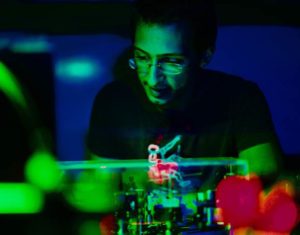Testing `spooky’ causation
- Post by: admin
- August 15, 2016
- No Comment
Last year saw the completion of a decade long quest to perform a successful Bell experiment without the three major and a few minor experimental loopholes. With local causality laid to rest, we can now start to unravel which of the many assumptions made by John Bell are incompatible with quantum mechanics. In a new experiment now published in Science Advances, we did just that., we did just that by allowing for `spooky’ causation between measurement outcomes. From the EQUS press release:
Research by an international team from Australia, the United Kingdom and Germany has shown that the gap between quantum phenomena and classical intuition is even bigger than previously thought.
In 2015, the universe was officially shown to be weird when a series of experiments demonstrated that entangled quantum particles remain instantly connected, no matter how far apart they are, through what Einstein famously dismissed as “spooky action at a distance”.
While it was shown that entanglement does not follow the classical rules of cause and effect, researchers continue to puzzle over how it really works.
Associate Professor Alessandro Fedrizzi from Heriot Watt University said that one popular explanation is that entangled objects could affect each other instantaneously, which ignores the universal speed-of-light limit.
He said, “In our experiment, we showed that this model cannot explain the experimental observations”.
We all intuitively understand and apply the concepts of cause and effect every day in our lives. Martin Ringbauer from the ARC Centre of Excellence for Engineered Quantum Systems said, “Picture yourself in a room where someone is flicking a light switch. Intuition and experience lets you establish a simple causal model: the switch causes the lights to turn on and off. In this case, correlation implies causation.”
“If we could entangle two lights, you would see them turn on and off at random, regardless of how far apart they are, with no obvious switch and in perfect lockstep. Einstein’s preferred explanation of this mysterious effect was that there must be a hidden light switch which acts as a common cause for our entangled lights.”
“In our experiment, our team set up individual photons to act like entangled lights and subjected them to two tests. In the first test, we essentially flicked the light switches ourselves to test a causal hypothesis. In the second, we tested a theory from one of our collaborators Rafael Chaves, which proposed that nonlocal causality cannot explain quantum entanglement.”
These results, published in the journal Science Advances, bring us a step closer to understanding the nature of this “spooky action at a distance”. Besides the fundamental importance, they also have potential applications for cyber-security. They can for example be used to increase the level of trust we have into quantum encryption devices.

For the experts, what we really mean by `spooky’ causation, or `nonlocal causality’ as we labeled it in the title, is outcome dependence. Outcome dependence refers to the possibility that the outcomes of two measurements on entangled particles could have a classical cause-and-effect relation. We found that they don’t, no matter at which speed this cause-and-effect relation could be established.
So what does this mean, is this just another test of something-or-other that doesn’t actually enhance our understanding of quantum foundations? On the contrary. Outcome dependence was in fact a contender for explaining entanglement in a number of circles, in particular for people interested in the philosophy of science. And before you scoff at that as a hardened physicist, philosophers interested in quantum foundations have thought longer and harder about concepts such as causation, correlations, the arrow of time, and others than many of our own colleagues in the field.
So what are the caveats? On the one hand, we had to apply fair sampling — the requirements to beat the detection loophole in the otherwise device-independent 3-setting inequality we tested are in fact more stringent than for Bell (or rather: Eberhard) inequalities. Space-time separation is however not a problem, since our hypothetical causation could happen above light-speed anyway and still be ruled out. Furthermore we didn’t test for parameter (in)dependence.
What this shows though is that causal modelling and its application to quantum foundations has given us a fresh viewpoint, including that it allows for novel tests. It will be very exciting to see where the program of quantum causal models, which are now adapted to reconcile quantum mechanics with a causal world view will lead.
UPDATE: Physicsworld puts a nice spin on our results here.
DerStandard reports in German.
And here’s me playing a dubious expert on BBC radio, alongside science communicator Chad Orzel (starting at the 19:00 minute mark).